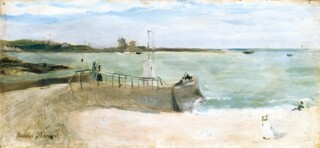The organisers are almost bashful about the exhibition Impression: Painting Quickly in France, 1860-90, which runs at the National Gallery until 28 January. Impressionist pictures are guaranteed to draw a crowd. But the individual painters, the social context, optical science and technique have all, as they point out, been analysed in books. Most of these elements have been given shows of their own.
So they set out to renew the genre by suggesting that you look closer: that you look at the paintings as things; that you think about the paint itself and about the rough, direct, sketchy dabs and flicks with which it is put on the canvas; that you notice the rhythms – swirling or staccato – of brush marks and the way these blend and overlap; that you search all these for evidence of the processes by which the picture was made. In these matters, the three-dimensional surface of the picture is as important as the two-dimensional image. There are plenty of details in the exhibition catalogue by Richard Brettell (Yale, £16.95) which help you appreciate what is going on at brush-stroke level, but to test what is said you must go to the paintings themselves.
In the pictures on show the size of the marks is large in relation to the size of the canvas and the elision of detail is extreme. The paintings also tend to be smaller than those in your average Impressionist exhibition. But they are not studies or preliminary sketches: many were signed and sold very soon after they were painted; proof that they were considered finished by both painter and patron.
Sketchiness was what shocked people when the first Impressionist pictures were shown. This show gives one a chance to do a thought experiment: to try to see images which are now reproduced on the least demanding birthday cards and carrier bags as radical and difficult. Although you need not try too hard – Richard Brettell quotes enough contemporary critics to remind you that plenty of people liked Impressionist pictures from the first – you will appreciate that the new surface would have displeased anyone committed to the enamel-smooth facture of David, Ingres and the Salon conservatives.
Much of what seemed new could, of course, be found in the detail of old pictures. Brettell, imagining the stimulus to gestural painting a visit to the Louvre would have offered an Impressionist painter, reproduces details of dead meat from Rembrandt, hair from Rubens, a sleeve from Hals – even a snatch of distant landscape from Ribera. In all of these the nature of the performance can be read from what the paint tells about the path of the brush. There was a long tradition of small landscape paintings made from nature, and the Barbizon painters also made fluent gestures with big brushes. Besides, every kind of painter produced studies and sketches which, though not intended for exhibition were, in a sense, impressions – if only of paintings to follow. In trying for a definition of Impressionism Brettell ends with the thought that a picture which might seem to be in an unfinished state was in fact ‘completed by the artist, through the act of signature and exhibition’.
The implication that completion was, or was allowed to appear, arbitrary puts the viewer in a new relation to the work. We are encouraged to carry the process begun by the painter to a conclusion of our own. It may be richer and will certainly be more personal than any a resolved finish could achieve. The innate vitality and productive ambiguity of the marks on the canvas mediated a modern way of looking. Drawings and sketches had always given connoisseurs the thrill of making their own resolution. Here it was extended to create a new genre – the finished unfinished work.
Impressionist pictures were absorbed quickly into popular culture, but the feeling that the price of openness had been too high, that the paintings lacked structure, was apparent early on. Matisse wrote in 1908 that he was willing to ‘risk losing charm in order to obtain greater stability’. Evidence to refute the argument that Impressionism was mindless automatic writing comes from the paintings themselves in the form of adjustments to composition and layers of marks added after those below had begun to dry, both features pointing to second thoughts and studio reworking.
Berthe Morisot takes her place easily here – in no sense the token female. You notice in earlier pictures like The Jetty and Hanging the Laundry out to Dry, both of 1875, thin straight lines – the railing in the former picture, for example, and what look like pea-sticks in the latter – which stitch the picture together and counteract the buttery, smeared quality of other marks. These lines look as though they were made with a fine, rather long-haired brush, or perhaps with the edge of a flat one. Brettell writes about Morisot and Renoir together under the heading ‘The Wetness of Paint and the Sketch Aesthetic’ and reproduces Renoir’s The Dreamer (a girl with her finger in her mouth) and Morisot’s Le Corsage noir (a woman against a boldly painted background of a screen and plants). He comments on Morisot’s more aggressive gestures and the ‘connoisseur’s variety of marks’ that he observes in Renoir. Having been asked to notice individual calligraphies one sees that the same scattering of straight, very fine lines (a couple in white on the bodice of the black dress, a stray wisp of hair, the eyelashes on the right eye, twigs in the plant behind her) are again used to focus the image. You find similar devices in some of Sargent’s Paris pictures. Because Impression persuades you to start looking at all marks more analytically you become aware of calligraphies which do not follow iconographic or even stylistic boundaries.
Send Letters To:
The Editor
London Review of Books,
28 Little Russell Street
London, WC1A 2HN
letters@lrb.co.uk
Please include name, address, and a telephone number.


